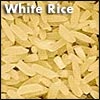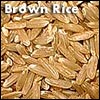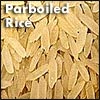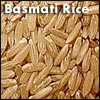All About Rice

Rice, a traditional staple food of the Orient, has gradually become a food that is used around the world. A primary food in many parts of Asia, rice makes up anywhere between 55% and 80% of the caloric intake in countries such as Bangladesh, Cambodia, Indonesia, Laos, Thailand and Vietnam where the average person eats up to 300 lbs. of rice a year. Up to 95% of the world's rice is consumed in Asia, grown within 5 miles of where it is consumed. As another example of how much a local crop rice is, of the world's 520 million metric ton crop grown world wide, only about 10% of it grown in the United States, yet the US is the largest exporter of rice in the world.
Yes, rice has been an important food in the Orient for thousands of years. But because of it's ease of cooking, good taste and it's high diversity in making literally thousands of different dishes, rice is becoming an ever more important part of the diet here in North America. Rice can be used as part of every meal of the day and in every dish served. Rice milk and rice crispies for breakfast, a rice snack at lunch and boiled rice in place of potatoes and rice pudding at dinner. Rice goes well with any vegetable and with most of the fruits. There are literally thousands of uses for rice in casseroles, salads and desserts.
It is believed that rice was first cultivated in central India but was quickly put into large cultivation by the Chinese. This happened as long as 5,500 years ago with rice quickly spreading throughout Asia. It took rice over 4,500 years to reach Europe in the 12th Century, AD. Then rice was brought to the Americas in the 1690s.
Most of us here in America only know of two kinds of rice - long grain brown rice and long grain white rice which is refined long grain brown rice. However, there are over 7,000 varieties of rice around the world. There are different varieties of medium length rice, and short grain rices as well whose kernels can be so stubby that the seed is almost round in shape. As 99% of the rice eaten in North America is long grain brown or white rice, we will restrict most of our comments to these two rices. However, you will see a small section on Basmati rice at the bottom. Brown rice is turned into white rice by polishing the outer layers off. With the outer layers removed, the rice cooks a little quicker, is easier to chew and because it's flavor is a bit more bland, can be more easily made into more foods than brown rice. In it's unrefined form, brown rice has a very short shelf life of 6 to 12 months. This is because the fatty acids, unprotected from the air in the outer layers of the kernel go rancid relatively quickly. In it's refined form, white rice will store for many years if carefully preserved. But there's a big problem with white rice. The majority of the nutrients in the rice kernel are in the layers that are removed. What's left is mostly starch. As refined rice is 81%-83% carbohydrates, it's considered a high energy food. But on the flip side of this, many of the nutrients needed for correct digestion of white rice were removed during the milling process which forces the body to 'steal' from it's reserves to digest it. Compared to brown rice, white rice's nutrients have been greatly reduced in fatty acids, fiber (which is already low in brown rice compared to some of the other grains), vitamin E, thiamin, riboflavin, niacin, vitamin B6, folacin, potassium, phosphorus, magnesium, iron, zinc and copper. The amino acids remain relatively unchanged. (See the rice comparison table at the bottom of this paper.) As white rice is so poor nutritionally, it is usually fortified with several of these same nutrients that were removed. These fortified vitamins are usually in the form of a powder on the outside of the rice. If you wash your white rice before cooking it, you will wash off the majority of these added nutrients. When you eat brown rice, you eat all the natural nutrition that comes with this grain. After becoming accustomed to brown rice, many people like it just as much or better with it's more robust flavor and more hardy texture. We have come to understand brown rice will stay fresh for years if it is packed in the absence of oxygen then stored in a cool place. With the oxygen removed, there's little oxygen to oxidize the fatty acids. This greatly retards the aging process.
Brown rice is turned into white rice by polishing the outer layers off. With the outer layers removed, the rice cooks a little quicker, is easier to chew and because it's flavor is a bit more bland, can be more easily made into more foods than brown rice. In it's unrefined form, brown rice has a very short shelf life of 6 to 12 months. This is because the fatty acids, unprotected from the air in the outer layers of the kernel go rancid relatively quickly. In it's refined form, white rice will store for many years if carefully preserved. But there's a big problem with white rice. The majority of the nutrients in the rice kernel are in the layers that are removed. What's left is mostly starch. As refined rice is 81%-83% carbohydrates, it's considered a high energy food. But on the flip side of this, many of the nutrients needed for correct digestion of white rice were removed during the milling process which forces the body to 'steal' from it's reserves to digest it. Compared to brown rice, white rice's nutrients have been greatly reduced in fatty acids, fiber (which is already low in brown rice compared to some of the other grains), vitamin E, thiamin, riboflavin, niacin, vitamin B6, folacin, potassium, phosphorus, magnesium, iron, zinc and copper. The amino acids remain relatively unchanged. (See the rice comparison table at the bottom of this paper.) As white rice is so poor nutritionally, it is usually fortified with several of these same nutrients that were removed. These fortified vitamins are usually in the form of a powder on the outside of the rice. If you wash your white rice before cooking it, you will wash off the majority of these added nutrients. When you eat brown rice, you eat all the natural nutrition that comes with this grain. After becoming accustomed to brown rice, many people like it just as much or better with it's more robust flavor and more hardy texture. We have come to understand brown rice will stay fresh for years if it is packed in the absence of oxygen then stored in a cool place. With the oxygen removed, there's little oxygen to oxidize the fatty acids. This greatly retards the aging process. There are a couple of different ways white rice can be processed. The parboiling process takes brown rice, soaks it then steams it which drives many of the nutrients from the outer layers into the main endosperm part of the seed. It's then dried. After drying, the outer layers and germ are removed, turning it into parboiled, white rice. Parboiling the rice first increases it's nutrient value but parboiled rice still falls far short of the nutrition found in brown rice. But enough of the B vitamins have been driven into the kernel to prevent beriberi, a deficiency disease caused by a lack of thiamin. Eating only white rice, beriberi is almost a certainty.
There are a couple of different ways white rice can be processed. The parboiling process takes brown rice, soaks it then steams it which drives many of the nutrients from the outer layers into the main endosperm part of the seed. It's then dried. After drying, the outer layers and germ are removed, turning it into parboiled, white rice. Parboiling the rice first increases it's nutrient value but parboiled rice still falls far short of the nutrition found in brown rice. But enough of the B vitamins have been driven into the kernel to prevent beriberi, a deficiency disease caused by a lack of thiamin. Eating only white rice, beriberi is almost a certainty.
Instant rice has been fully cooked and is then dehydrated. It requires little more than hot water to reconstitute it. Being pre-cooked, instant rice could go well in your 72 hr kit or the small survival unit you keep in your car or boat. However, as it has been further processed, it's generally more expensive and although it has been fortified, is the least nutritious of the different kinds of white rice you can buy.
Taking about 90 minutes to cook (20 minutes if it's been pre-soaked), rice is customarily cooked once a day in the orient and eaten in various ways during the day. White rice is the least nutritious of all the grains. Should you decide to make rice one of the staples of your food supply, care should be taken to insure adequate vitamins and minerals are received from other sources. Although rice has it's problems nutritionally as a stand-alone food, it's a great energy source. And although it's low in protein, as compared to some of the other grains, the protein rice does contain is more available than the amino acids in wheat. The good news is you wouldn't get a protein deficiency even if the only thing you ate was rice. And among the grains, rice's amino acid balance is only bettered by oats. Lastly, although not as cheap per calorie as wheat, rice is a great buy when considering energy VS cost and is much more versatile in it's whole grain form than wheat. Permit rice to add a lot of diversity to your food supply and day-to-day diet. Basmati rice, traditionally a special strain of rice from India and Pakistan, it's starting to be grown in North America as well. Indistinguishable from brown rice to the untrained eye, all one needs is a quick whiff of the Basmati rice to know they are not the same. Basmati rice has a strong, pungent odor that also has a much stronger flavor than regular long grain brown rice. When cooking Basmati rice, it's always a good idea to wash it first in water which washes away a bit of it's starch, making it less sticky when cooked. Sought after for Asian cuisine, many people have grown to love the flavor and texture of this rice grown half way around the world.
Basmati rice, traditionally a special strain of rice from India and Pakistan, it's starting to be grown in North America as well. Indistinguishable from brown rice to the untrained eye, all one needs is a quick whiff of the Basmati rice to know they are not the same. Basmati rice has a strong, pungent odor that also has a much stronger flavor than regular long grain brown rice. When cooking Basmati rice, it's always a good idea to wash it first in water which washes away a bit of it's starch, making it less sticky when cooked. Sought after for Asian cuisine, many people have grown to love the flavor and texture of this rice grown half way around the world.
and Unprocessed Long Grain Rice:
Brown White Rice Enriched Enriched
Raw Unenriched Parboiled Instant
Food energy KCal: 370.000 365.000 371.000 379.000
Protein Gms: 7.940 7.130 6.790 7.660
Total lipid (fat) Gms: 2.920 0.660 0.560 0.290
Carbohydrate, by diff. Gms: 77.240 79.950 81.720 83.590
Total saturated fat Gms: 0.584 0.180 0.151 0.078
Ttl monounsaturated fat Gms: 1.056 0.206 0.173 0.089
Ttl polyunsaturated fat Gms: 1.044 0.177 0.149 0.077
Cholesterol Mg : 0.000 0.000 0.000 0.000
Sodium Mg : 7.000 5.000 5.000 6.000
Total dietary fiber Gms: 3.500 1.300 1.700 1.600
Vitamin A Re : 0.000 0.000 0.000 0.000
Vitamin E Mg : 0.680 0.000 0.000 0.000
Thiamin Mg : 0.401 0.070 0.596 0.618
Riboflavin Mg : 0.093 0.049 0.070 0.060
Niacin Mg : 5.091 1.600 3.632 5.471
Vitamin B6 Mg : 0.509 0.164 0.350 0.044
Folacin Mcg: 20.000 8.000 17.000 6.000
Potassium Mg : 223.000 115.000 120.000 18.000
Calcium Mg : 23.000 28.000 60.000 18.000
Phosphorus Mg : 333.000 115.000 136.000 68.000
Magnesium Mg : 143.000 25.000 31.000 12.000
Iron Mg : 1.470 0.800 3.560 4.190
Zinc Mg : 2.020 1.090 0.960 0.960
Pantothenic acid Mg : 1.493 1.014 1.133 0.432
Copper Mg : 0.277 0.220 0.191 0.165
Manganese Mg : 3.743 1.088 0.850 0.647
Histidine Gms: 0.202 0.168 0.160 0.180
Isoleucine Gms: 0.336 0.308 0.293 0.331
Leucine Gms: 0.657 0.589 0.562 0.633
Lysine Gms: 0.303 0.258 0.246 0.277
Methionine Gms: 0.179 0.168 0.160 0.180
Cystine Gms: 0.096 0.146 0.139 0.157
Methionine+Cystine Gms: 0.275 0.314 0.299 0.337
Phenylalanine Gms: 0.410 0.381 0.363 0.409
Tyrosine Gms: 0.298 0.238 0.227 0.256
Phenylalanine+Tyrosine Gms: 0.708 0.619 0.590 0.665
Threonine Gms: 0.291 0.255 0.243 0.274
Tryptophan Gms: 0.101 0.083 0.079 0.089
Valine Gms: 0.466 0.435 0.414 0.467
Arginine Gms: 0.602 0.594 0.566 0.638
Alanine Gms: 0.463 0.413 0.394 0.444
Aspartic acid Gms: 0.743 0.670 0.638 0.719
Glutamic acid Gms: 1.618 1.389 1.325 1.493
Glycine Gms: 0.391 0.325 0.309 0.349Recipes:
http://www.unclebens.com/us/cookbook Uncle Ben's
http://recipes.alastra.com/rice/default.html Hundreds of Rice Recipes
http://www.godsbanquet.com/recipes/rice%20world.htm
Resources:
The Prudent Pantry by Alan T. Hagen
http://www.cup.org/books/kiple/rice.htm
http://www.bartleby.com/61/39/B0103950.html
http://www.godsbanquet.com/recipes/rice%20world.htm
http://www.cup.org/books/kiple/rice.htm